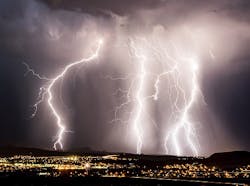There’s more to proper grounding and bonding than meets the eye. When tackling this type of work, the end goal is obviously to prevent unwanted voltage on non-current-carrying metal objects and facilitate the correct operation of overcurrent devices. But that doesn’t mean wiring everything to a ground rod and calling it a day. In order to provide safe installations to the public, there are certain subtleties you must follow in order to meet applicable NEC rules.
Although ground theory is a vast subject, we’ve put together 10 of the most common grounding errors electricians run into on any given day in the field. This photo gallery is based on “The 10 Worst Grounding Mistakes You’ll Ever Make” article written by Master Electrician David Herres, which originally ran in the August 2008 print issue of EC&M.
Read about each error in the top right-hand corner with each slide, or click on the full article to find out more details on how to avoid the most common errors in residential, commercial, and industrial wiring that ultimately lead to fire and electric shock hazards.
Here's are two more galleries you might find interesting:
About the Author
David Herres
Licensed Master Electrician
David Herres is a licensed master electrician in Stewartstown, N.H. He can be reached at [email protected].
